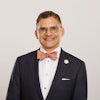
In the dynamic landscape of contemporary dentistry, the integration of artificial intelligence (AI) has emerged as a transformative force, poised to redefine clinical workflows and patient care.
During a recent conversation with VideaHealth CEO Florian Hillen, a trailblazer in dental AI, and Dr. Timothy Quirt, a seasoned clinician, an advocate for technological advancement in dentistry, and senior vice president for Heartland Dental, we discussed the pivotal role of AI in shaping the future of the profession. During our discussion, it became evident that both men believe 2024 marks a significant milestone in the adoption and utilization of AI in dental practices.
 Florian Hillen.
Florian Hillen.
Hillen initiated our wide-ranging conversation by explaining the convergence of technological innovation and market demand as primary drivers behind the prioritization of dental AI. He emphasized the culmination of years of meticulous development, leading to a pivotal moment where AI solutions like VideaAI have demonstrated tangible benefits in enhancing both patient care and financial returns.
"It's really a useful product, which has measurable results," Hillen said.
This sentiment resonates with Quirt, who emphasized the transformative impact AI has on clinical workflows, citing its role in improving diagnostic accuracy and facilitating informed treatment decisions.
Reflecting on the journey toward widespread adoption, Quirt emphasized the importance of change management and fostering a sense of urgency among dental practitioners. He applauded the collaborative approach taken by organizations like Heartland Dental in engaging clinicians and soliciting feedback to ensure the seamless integration of AI into daily practice workflows.
 Dr. Timothy Quirt.
Dr. Timothy Quirt.
"You need to subscribe to some type of change management program ... It's about creating a sense of urgency," Dr. Quirt said.
Both Hillen and Quirt stressed the need for AI solutions to augment rather than replace clinical expertise. Hillen emphasized the collaborative nature of AI integration, highlighting the clinician's autonomy in diagnostic and treatment decisions.
"It's not the dentist versus the AI or the hygienist versus the AI. It's really the clinician with the AI," Hillen said.
This collaborative paradigm ensures that AI serves as a supportive tool, empowering clinicians to deliver optimal care while streamlining administrative tasks.
Addressing concerns about trust and liability, Quirt emphasized the role of AI as a supplementary diagnostic tool, providing clinicians with an additional set of eyes to detect subtle pathologies.
"It's that third party also validating ... Patients need to be able to do what they want, need, and desire, and that's what this does,” Quirt explained.
Hillen echoed this sentiment, highlighting the rigorous U.S. Food and Drug Administration clearance process and extensive training data utilized to ensure the accuracy and reliability of AI algorithms.
Looking ahead, both Hillen and Quirt expressed optimism regarding the transformative potential of AI in addressing critical challenges facing the dental profession, such as the ongoing staffing shortage. Quirt said he envisions AI as a catalyst for operational efficiency, enabling dental teams to focus on patient-facing interactions while automating administrative tasks. Hillen, meanwhile, emphasized the collaborative nature of AI implementation, stressing the importance of partnership and ongoing refinement to meet the evolving needs of dental practices.
Quirt elaborated on the significance of AI in alleviating the burden of administrative tasks, particularly amid the staffing shortage. He emphasized the importance of leveraging technology to optimize practice workflows, enhance patient experiences, and increase case acceptance.
"We want them talking to patients and helping patients. I don't want them holed up in an office doing things that could be supplemented with AI," Quirt said.
Hillen echoed Quirt's sentiments, highlighting the potential of AI to streamline administrative processes and empower dental teams to focus on patient care. He emphasized the need for AI solutions to automate mundane tasks and facilitate seamless communication within the practice.
"We need to have a solution to that, and we hope to be part of the solution and work closely with Tim's team and other customers on really identifying where we can help the most," Hillen offered.
As the discussion continued, both speakers waded into the broader implications of AI adoption in dentistry, emphasizing its role in driving practice efficiency and enhancing patient outcomes. Quirt said that AI solutions need to adapt to the evolving needs of dental practices and address critical pain points, such as staffing shortages. He emphasized the collaborative approach taken by organizations like Heartland Dental in leveraging AI to optimize practice workflows and improve patient experiences.
Reflecting on the potential of AI to revolutionize dental education, Hillen emphasized its role in preparing future generations of clinicians for the digital era. He envisions AI becoming an integral component of dental curricula, empowering students to leverage technology in clinical practice.
"Every dental student is going to use this ... It's like having a calculator in your pocket ... We all have phones with calculators. That's what's happening right here," Hillen said.
This year could well herald a new era in dentistry. With a shared vision of leveraging technology to empower clinicians and optimize patient care, innovators are paving the way for a future where dental AI becomes an indispensable ally in the quest for oral health excellence.
You can listen to our entire conversation by clicking below or clicking here. Read how Heartland and Videa Health are working together here.



















